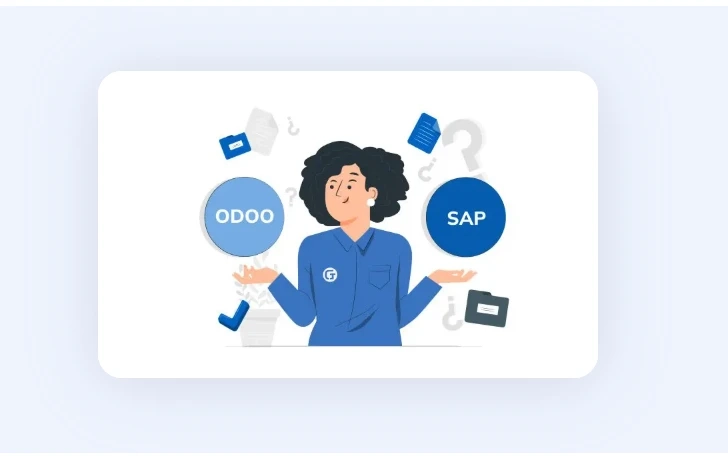In today’s fast-paced business world, adaptability is no longer just an advantage—it’s a necessity. Businesses need ERP (Enterprise Resource Planning) systems that not only integrate core operations but also adapt to their unique processes, markets, and growth ambitions. This is where the odoo vs sap debate becomes highly relevant, especially when customization and flexibility are at stake.
Both Odoo and SAP are powerful ERP platforms, yet they follow fundamentally different philosophies. Odoo’s open-source model offers limitless customization opportunities, while SAP’s enterprise-focused model emphasizes standardized, robust, and industry-tested solutions. Each approach has its strengths, trade-offs, and ideal use cases.
In this detailed comparison, we’ll explore how odoo vs sap erp stacks up when it comes to customization and flexibility—helping you make the right decision for your organization.
1. Understanding the Two ERP Philosophies
Before diving into customization capabilities, it’s essential to understand the core philosophies behind Odoo and SAP.
Odoo’s Open-Source Approach
Odoo is an open-source ERP solution that allows businesses to access, modify, and extend its source code. This means your development team—or an external partner—can tailor the platform to fit your exact processes. Its modular design (with thousands of official and community apps) enables companies to start small and expand functionality as needed.
For organizations that thrive on innovation, Odoo’s approach offers the freedom to experiment, integrate niche tools, and adapt quickly to market changes.
SAP’s Enterprise Model
SAP, on the other hand, follows a closed-source, enterprise-grade model. While customization is possible, it is typically done within a structured framework, using SAP’s proprietary tools, certified consultants, and pre-defined processes. This approach prioritizes stability, compliance, and industry best practices over limitless modification.
For large organizations in highly regulated industries, SAP’s model ensures that changes follow strict governance, reducing risks while maintaining global operational standards.
2. Customization Capabilities: Odoo vs SAP
When comparing sap vs odoo in terms of customization, the distinction lies in how each platform enables changes.
Odoo: Full Code Access
- Advantages:
- Complete access to the source code allows deep-level changes.
- Can integrate with almost any third-party system through custom APIs.
- No vendor lock-in—you own your customizations.
- Community-driven modules speed up development.
- Example:
- If your manufacturing process involves unique quality checks or custom workflow steps, Odoo can be tailored to automate them entirely.
SAP: Controlled Customization
- Advantages:
- Uses a set of proprietary tools like ABAP for customization.
- Provides industry-specific templates to minimize development time.
- Focus on maintaining system integrity and security.
- Limitations:
- Customizations are often more expensive due to licensing and consultant costs.
- Deeper modifications require SAP-certified expertise.
- Example:
- SAP’s customization might allow you to tweak order processing workflows, but within the constraints of SAP’s data models and compliance rules.
3. Flexibility in Deployment
Flexibility isn’t just about coding—it’s also about how the system is deployed and scaled.
Odoo’s Deployment Flexibility
Odoo can be deployed on-premises, in the cloud, or in a hybrid setup. You can host it yourself, use Odoo.sh (Odoo’s cloud), or choose any hosting provider. This adaptability is ideal for businesses that need control over infrastructure costs, compliance, or data residency.
SAP’s Structured Deployment Options
SAP offers on-premises (SAP ECC, SAP S/4HANA), private cloud, and public cloud versions. However, deployment choices often come with strict requirements, especially for cloud setups, and changes to hosting environments can involve complex migration processes.
4. Scalability and Evolution
ERP systems should grow with your business.
- Odoo: Modular architecture means you can start with just a CRM or inventory module and add others as you expand. Each module can be customized independently, keeping implementation lean.
- SAP: Designed for large-scale operations from the start. While it scales well for massive enterprises, smaller businesses might face over-complexity if they don’t need all the capabilities upfront.
5. Integration Capabilities
Integration flexibility is a key factor in the odoo vs sap erp debate.
Odoo Integrations
- Supports REST and XML-RPC APIs for easy third-party integration.
- Large library of community-built connectors (e-commerce platforms, payment gateways, shipping providers).
- Open-source nature means integrations can be built from scratch without licensing restrictions.
SAP Integrations
- Offers robust integration tools like SAP PI/PO, SAP CPI, and pre-built connectors for major enterprise software.
- Strong focus on integration with other SAP products (e.g., SAP SuccessFactors, SAP Ariba).
- Non-SAP integrations are possible but often involve more complexity and cost.
6. Cost Implications of Customization
Customization comes with both direct and hidden costs.
- Odoo: Lower entry costs since licensing is minimal (open-source version) or based on affordable subscription pricing. Customization costs depend on developer rates, which can vary widely.
- SAP: Higher licensing fees, plus the added expense of SAP-certified consultants for customization. While the investment can lead to highly stable solutions, it may not be cost-efficient for smaller or mid-sized companies.
7. Risk Management in Customization
Excessive customization can lead to system instability if not managed well.
- Odoo’s Risk: Since customization is unrestricted, there’s a risk of over-engineering, leading to maintenance challenges if development standards aren’t followed.
- SAP’s Risk: Over-customization can lead to difficult upgrades, especially if core functionalities are altered. SAP mitigates this with strict governance, but it limits flexibility.
8. Industry Suitability
- Odoo: Best for SMEs, startups, and innovative enterprises that want to differentiate processes and need a system to adapt quickly. Particularly strong in retail, manufacturing, services, and e-commerce.
- SAP: Ideal for large corporations, multinational organizations, and industries with strict compliance needs (finance, pharmaceuticals, automotive).
9. Upgrade and Maintenance Flexibility
Odoo:
- Upgrades can be managed internally or with a partner.
- Customizations may require additional effort during upgrades, but since the code is open, developers can adapt freely.
SAP:
- Upgrades are highly structured, but custom code must be tested and adjusted to ensure compatibility with new releases—often requiring significant effort and cost.
10. Decision-Making Guide: Odoo vs SAP ERP
Here’s a quick comparison table for reference:
Feature / FactorOdoo (Open-Source)SAP (Enterprise Model)Customization LevelUnlimitedControlledDeployment FlexibilityVery highModerateIntegrationEasy, open APIsStrong, but complexCostLowerHigherScalabilityIncremental growthMassive scale-readyUpgrade ImpactManageableOften complexBest ForSMEs, innovatorsLarge enterprises
11. Real-World Example
Imagine two companies:
- Company A (Mid-sized manufacturer): Needs a system to manage production, sales, and inventory with unique workflows. They choose Odoo, customizing modules for their specific production process, integrating with niche IoT devices, and deploying on their own cloud server for cost savings.
- Company B (Global automotive supplier): Needs a unified ERP system across 15 countries, adhering to strict compliance standards and industry regulations. They choose SAP, using its pre-configured industry templates and certified consultants to ensure global standardization.
Conclusion: Which Is Better for Customization and Flexibility?
When it comes to odoo vs sap, there’s no one-size-fits-all answer.
- Choose Odoo if you want maximum control, rapid innovation, lower upfront costs, and the ability to customize every corner of your ERP without vendor restrictions.
- Choose SAP if your organization prioritizes standardization, global compliance, and a proven enterprise model with structured governance.
In the end, your choice between sap vs odoo should align with your company’s size, industry requirements, and appetite for customization. While Odoo offers unmatched flexibility through its open-source foundation, SAP delivers a stable, enterprise-tested environment where customization is carefully controlled.
For businesses navigating the odoo vs sap erp decision, the right ERP isn’t just about features—it’s about finding the perfect balance between adaptability and reliability.



